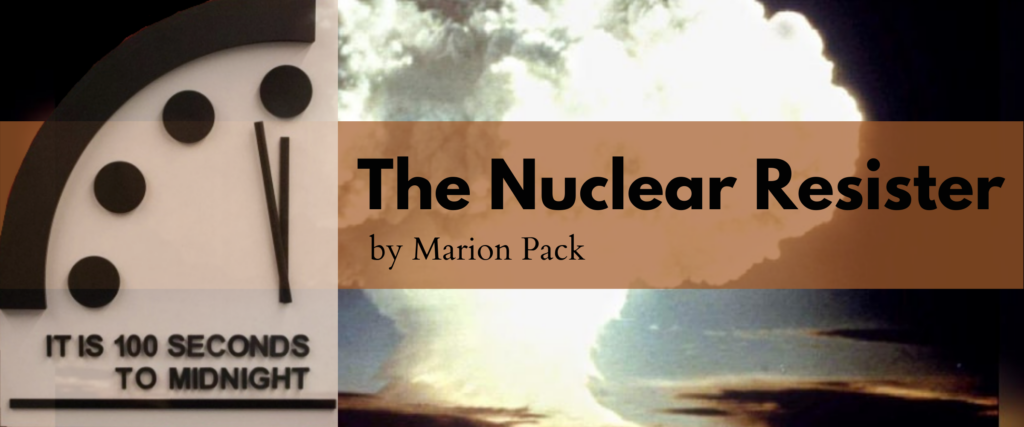
Nuclear Resister issue # 10
FOR IMMEDIATE RELEASE: June 29, 2021
Media Contacts:
Leslie Lenhardt, South Carolina Environmental Law Project, (843) 527-0078, [email protected]
Marylia Kelley, Tri-Valley CAREs, in CA, (925) 255-3589, [email protected]
Tom Clements, SRS Watch, in S. Carolina, (803) 834-3084, [email protected]
Jay Coghlan, Nuclear Watch NM, (505) 989-7342, c. (505) 470-3154, [email protected]
John Pope, ReThink Media, (717) 386-9270, [email protected]
Lawsuit Filed Against Biden Administration Over Nuclear Bomb Core Production Plans
Federal agencies’ refusal to review cross-country expansion of plutonium pit production violates the National Environmental Policy Act and the Administrative Procedures Act, groups say.
AIKEN, S.C. – Today, a coalition of community and public interest groups filed a lawsuit against the U.S. Department of Energy (DOE) and the National Nuclear Security Administration (NNSA). This legal action is prompted by the agencies’ failure to take the “hard look” required by the National Environmental Policy Act at their plans to more than triple the production of plutonium pits and split their production between the Los Alamos National Laboratory in New Mexico and the Savannah River Site in South Carolina.
A plutonium pit is the heart and trigger of a nuclear bomb. Production involves the extensive processing and handling of extremely hazardous and radioactive materials. In 2018, the federal government called for producing at least 80 pits per year by 2030, including 30 or more at Los Alamos and 50 or more at the Savannah River Site. The new plutonium pits are intended for the W87-1, a controversial new warhead under development at the Lawrence Livermore National Laboratory in California. Its novel design will necessitate new pits and require all of the cores manufactured at both production sites through 2038 or later, according to government documents.
Nuclear Watch New Mexico, Savannah River Site Watch and Tri-Valley Communities Against a Radioactive Environment have reached out to DOE and NNSA on more than six occasions since 2019 over the legal requirement for a broad, nationwide programmatic environmental impact statement, or PEIS, for producing the plutonium pits at Los Alamos and the Savannah River Site. However, in its March 22, 2021 correspondence (download PDF) with the groups, NNSA said it has no plans to revisit its review of pit production, relying instead on a supplemental analysis of an outdated PEIS completed more than a decade ago, along with a separate standalone review done solely for the Savannah River Site.
The agencies’ piecemeal, post-hoc evaluation of this programmatic shift is arbitrary and capricious and violates the Administrative Procedures Act and the National Environmental Policy Act, according to the challenge filed today in the District of South Carolina, Aiken Division by the South Carolina Environmental Law Project on behalf of the groups. PDF of the Complaint at https://bit.ly/3y93yUW
The lawsuit seeks to force the Defendants to involve the public in the review and decision-making process and to evaluate the environmental impacts of the significantly altered pit production plan, including the environmental justice implications for the many underserved communities that are located near these facilities. NNSA has conducted NEPA reviews only for specific portions of this larger connected plan of plutonium pit production and have not evaluated on a programmatic level critical issues such as the impacts on all DOE sites involved in pit production; the storage capacity for disposal of wastes generated by the pit production process and the array of new information that casts significant doubt over the feasibility of this plan.
Production of pits at the Savannah River Site would require the complete overhaul of a failed project known as the Mixed Oxide Fuel Fabrication Facility, of which over $7 billion was wasted. The February 2020 cost estimate of $4.6 billion for the Savannah River Site alone has now skyrocketed to $11.1 billion, as confirmed in the NNSA’s budget request of May 28, 2021. In recent Congressional testimony, NNSA leaders have already said that the 2030 goal for production of 50 pits per year at SRS may need to be pushed back to 2035.
“Recent events demonstrate that the agencies have significantly underestimated the timeline and expense associated with this proposed action, making the timing of this lawsuit even more appropriate,” said Leslie Lenhardt, staff attorney for the South Carolina Environmental Law Project. “The evidence is overwhelming that any of the NEPA analyses that have been done are outdated and have not taken into consideration any of the significantly different circumstances that have arisen since 2008. It is imperative that NNSA correct glaring environmental-review deficiencies and conduct a thorough programmatic EIS on the impacts of pit production across the DOE complex.”
Jay Coghlan, Executive Director of Nuclear Watch New Mexico, commented, “NNSA has tried four times to expand plutonium pit bomb core production, but failed each time due to overwhelming citizen opposition. NNSA is now cutting the public out by refusing to complete nation-wide review of expanded pit production for controversial new-design nuclear weapons. We file this lawsuit to enforce the legal right of citizens to speak out on the hundreds of billions of taxpayer dollars that will be squandered in the new nuclear arms race.”
Tom Clements, director of SRS watch, in Columbia, S.C., said, “DOE’s rushed planning to unnecessarily expand nuclear bomb production has already resulted in a massive cost increase and significant delays in the SRS plutonium bomb plant. While more delays and cost increases appear likely, it is essential that DOE slow down and comply with requisite environmental laws before jumping into ill-conceived plans to expand plutonium pit production which would be a key part of a dangerous new nuclear arms race.”
Marylia Kelley, of Tri-Valley CAREs in Livermore, Calif, charged “NNSA’s refusal to undertake a programmatic review of its pit production plan is intended to allow the agency to dodge analysis of reasonable alternatives. For example, LLNL’s W87-1 design is driving both the schedule and ‘need’ for expanded pit production. The warhead’s novel design features are elective; a refurbishment option could meet stockpile requirements without necessitating expanded pit production. NNSA is robbing the public of its right to comment on alternatives, yet those of us in frontline communities will bear the brunt of this refusal. It is workers and the public who will suffer the risks of accidents, spills, leaks, radioactive exposures, and the production and transportation of plutonium wastes.”
# # #
The South Carolina Environmental Law Project uses its legal expertise to protect land, water, and communities across South Carolina.
Savannah River Site Watch (https://srswatch.org/) is based in Columbia, SC and monitors DOE activities at SRS. Nuclear Watch New Mexico (https://nukewatch.org/) is based in Santa Fe, New Mexico and focuses on nuclear weapons activities at the Los Alamos National Laboratory. Tri-Valley Communities Against a radioactive Environment (Tri-Valley CAREs, http://www.trivalleycares.org//) is located in Livermore, California and monitors the Lawrence Livermore National Laboratory, a key nuclear-weapons-design facility.
News conference archived on the Facebook page of the South Carolina Environmental Law Project: https://www.facebook.com/scelp.org.
